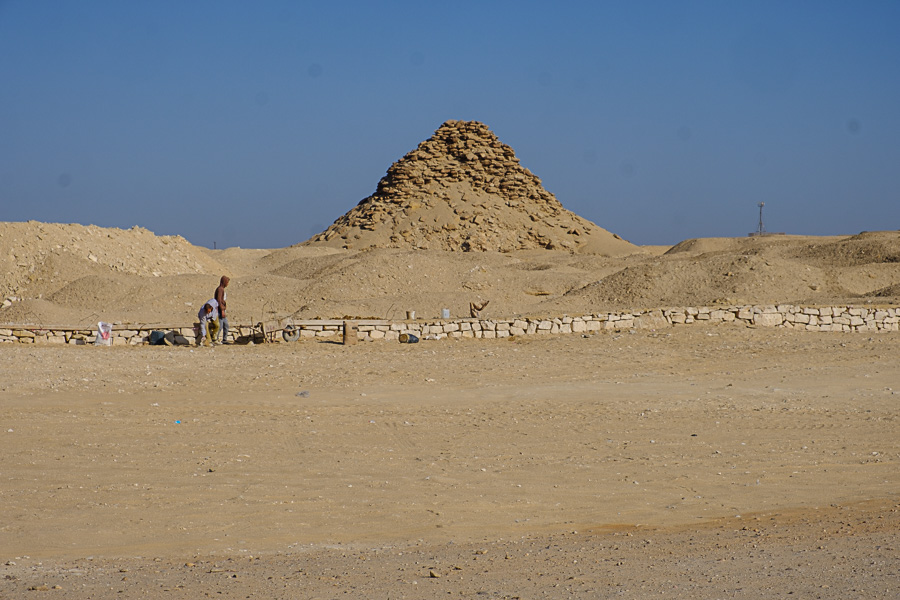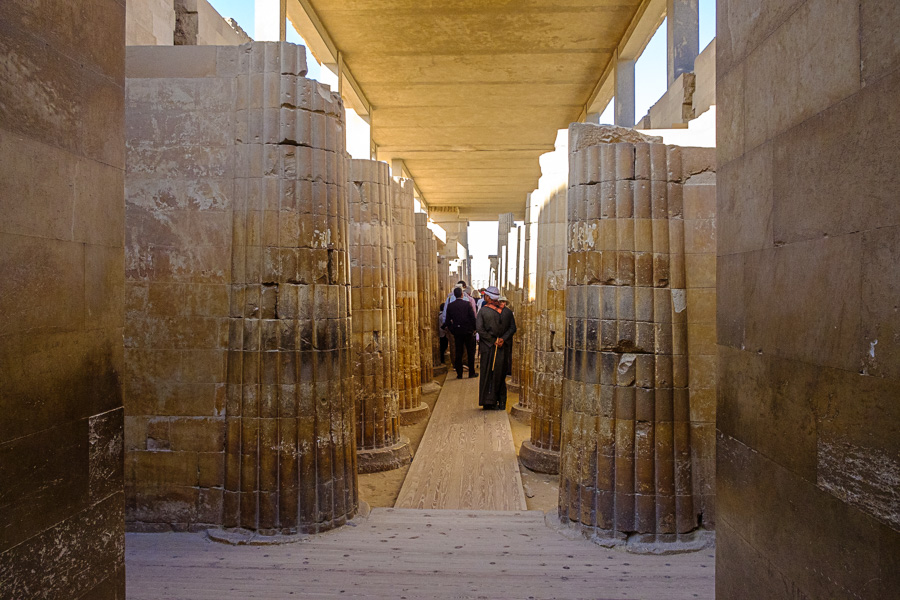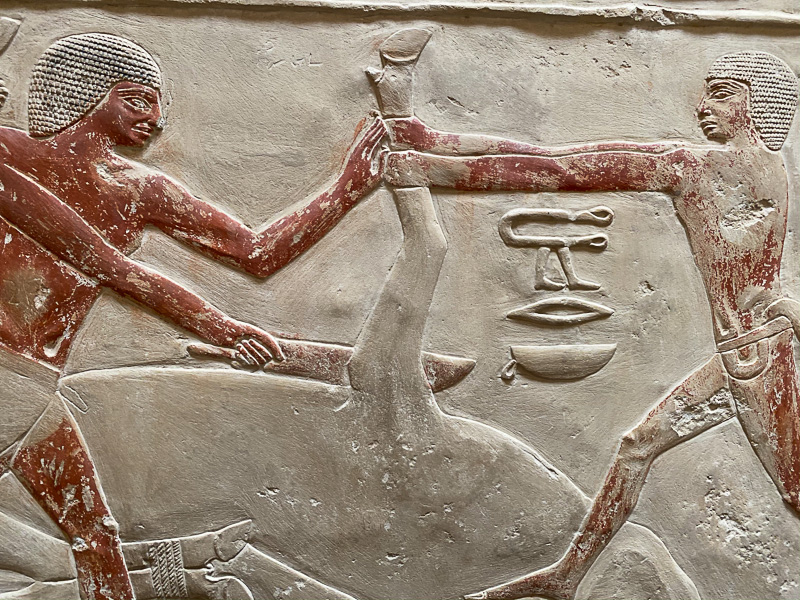Over 4,600 years of religious history in one day, our last in Egypt. Not bad! Ramses II snuck in a final appearance when we weren’t looking.
The Step Pyramid in the Saqqara is the final resting place of Pharaoh Djoser who was the first king of the Third Dynasty around 2600 BCE. It has (or had) six levels rather than a continual rise from base to cap. Hatem points out that this is not truly a pyramid. Djoser’s wife observed that the usual practice was to build mortuaries that were slightly elevated above ground level. “Why not do it one better? Build a mortuary for yourself that is higher. “Mastaba” is the Arabic word for the lower mortuary; this is really a step mastaba. There is an accompanying palace, made of stone, that was to serve Djoser in the here-to-come. Most living structures of the time were made of mud brick, subject to rapid decay. Stone construction ensured lasting (at least 4,600 years so far) longevity.
Ok, another pharaoh, another tomb, another bunch of carving bragging about his dear close friends the gods. We’ve seen enough already. But nearby we viewed three mastabas of local dignitaries, not dignified enough to have a pyramid but rich enough to have a pretty elaborate, multi-roomed mausoleum all their own. Engraved on each tomb’s walls were scenes depicting normal life of everyday people (OK, everyday rich people). Boating, fishing, raising cattle, slaughtering cattle. These noblemen knew they weren’t cut out to become gods but they wanted to spend their time in the next world enjoying the luxuries they enjoyed in this world.
This mortuary of Saqqara complex includes several mounds of stone and dirt that are charitably counted as pyramids (137 or so in total, as I recall). In the distance we could see two others, one being quite misshapen. It’s called the Bent Pyramid. Constructed around the same time as the Step Pyramid, it seems that they hit a snag. “Boss, this pyramid isn’t going to make it. It’s already starting to come apart. It’s too heavy.” The solution: the angle was reduced so the peak was reached with fewer stones and hence less weight. The architect corrected the design; his next pyramid went up without a hitch. Trial and error on a pretty grand scale.
We stopped at a school for rug weaving. It’s a school because local kids can come and learn the art while still participating in their normal schooling. It sported, of course, a huge showroom of finished product, all hand made. A basic kid’s rug started at $120. Craftsman-quality goods ran $2,500 and up. It can take a year of manual labor to do a good-sized rug; given the ton of product in the showroom they must have a small army working.
We also made a quick stop in Old Memphis. Memphis, on the east side of the river across from the necropolis, naturally, was the capitol of Egypt during the Old Kingdom. Today it is a small town with a small outdoor museum of antiquities dug up in the area. There are fewer antiquities found in this region for a couple of reasons: the Nile flooding covered much of the ruins with silt so many items remain underground. Also, the climate is damper here than in the south, so things deteriorate more rapidly here.
But there, smack dab in the middle of everything, were not one but two huge statues of Ramses II. They guy just didn’t quit. One is the twin to the version that stands in front of the Cairo train station except that this one fell over when his legs collapsed.
Then lunch, another mixed grill, another batch of home-baked bread cooked in a wood burning oven by a nice lady.
Jumping forward 2,600 years, we visited teo Coptic Christian churches. One was built on top of a Roman fortress. One included an underground chamber where Jesus and his folks spent time during their nearly four-year sojourn in Egypt. Saint Mark came to Egypt in 61 AD and Egypt remained a place or relative safety for Christians until Emperor Constantine freed things up when he converted in 313 AD. Today, Coptics make up about 15% of Egyptians. Coptic Christians can be thought of as being the same idea as Greek Orthodox and Russian Orthodox. In fact, there is a Greek Orthodox church right next door to the Coptic church.
How about Jews? Today there are only 40 Jewish families in Cairo and the same is true in Alexandria and elsewhere in Egypt. Jews left Egypt in the Twentieth Century for three main reasons. First, Nassar nationalized most businesses and property, causing Jews (and others) to go elsewhere for economic reasons. The creation of Israel lured many Egyptian Jews to emigrate. And then the series of wars with Israel gave Jews, even those who were Egyptian citizens, a stigma that made life in Egypt difficult.
We visited a church that was originally Christian but was sold in hard economic times to a Jewish man who converted it to a synagogue. Jewish law requires 10 men to hold a service. There aren’t enough Jewish men to hold a service, even when men from the Israeli embassy are recruited. The Department of Antiquities funds maintenance of the building.
We ran the gauntlet of one final open-air bazaar (I bought a refrigerator magnet photo taken in the 1920s of Gaza pyramids during Nile flooding for 20 EP), boarded the bus and returned to the hotel. The farewell dinner is tonight and we’re off to Jordan at 5:30 AM.
Some of you may have wondered about security and safety for us in Egypt. It’s been quite safe with no perceived threat whatsoever. However, metal detectors are at every tourist venue, our group has been escorted almost everywhere by an armed guard and our bus has been escorted by a two-man police car detachment while in Cairo. There’s even a sniffing dog at the entrance to our hotel here in Cairo.










































